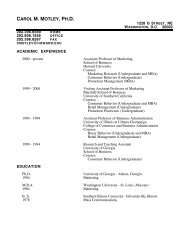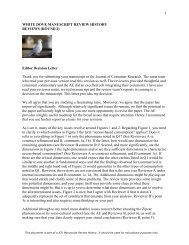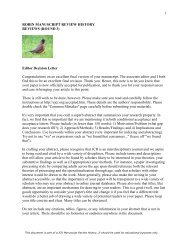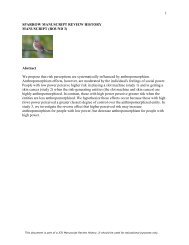Why Happiness Helps You See the Big Picture - Journal of ...
Why Happiness Helps You See the Big Picture - Journal of ...
Why Happiness Helps You See the Big Picture - Journal of ...
Create successful ePaper yourself
Turn your PDF publications into a flip-book with our unique Google optimized e-Paper software.
Copyright <strong>Journal</strong> <strong>of</strong> Consumer Research 2008.<br />
Preprint (not formatted or copyedited).<br />
Do not quote or cite without permission.<br />
8<br />
was made to look good; as a result, coding <strong>the</strong>se surveys for valence was not viable.<br />
Thus, responses to <strong>the</strong> open-ended survey were coded for positivity similar to experiment<br />
1a and revealed similar results. A one-way ANOVA, with mood as <strong>the</strong> independent<br />
variable and <strong>the</strong> positivity index as <strong>the</strong> dependent variable, revealed a main effect <strong>of</strong><br />
mood (M positive vs. M negative = .34 vs. .10; F(1, 25) = 5.52, p < .05), and correlation<br />
analysis confirmed a relationship between <strong>the</strong> abstractness scores and <strong>the</strong> positivity<br />
scores (r = .73, p < .001).<br />
As in experiment 1a, to distinguish whe<strong>the</strong>r <strong>the</strong> effect <strong>of</strong> mood on construal level<br />
occurred because a positive mood increased positivity <strong>of</strong> associations that happened to<br />
correspond with construal or whe<strong>the</strong>r mood changed construal independent <strong>of</strong> positivity,<br />
we conducted additional analysis. We regressed <strong>the</strong> construal index onto mood (ß = .26,<br />
SE = .08; t(25) = 3.46, p < .01), we regressed <strong>the</strong> positivity index onto mood (ß = .24, SE<br />
= .10; t(25) = 2.34, p < .05), and we regressed <strong>the</strong> construal index onto <strong>the</strong> positivity<br />
index (ß = .60, SE = .11; t(25) = 5.37, p < .01). When we regressed <strong>the</strong> construal index<br />
onto mood and included <strong>the</strong> positivity index as a covariate, both <strong>the</strong> effects <strong>of</strong> positivity<br />
(ß = .49, SE = .11; t(57) = 4.29, p < .01) and those <strong>of</strong> mood (ß = .14, SE = .06; t(25) =<br />
2.25, p < .05) remained significant, suggesting that mood exerted an effect on construal<br />
that was independent <strong>of</strong> positivity <strong>of</strong> association. In contrast, when we regressed <strong>the</strong><br />
positivity index onto mood and included <strong>the</strong> construal index as a covariate, we observed a<br />
significant effect <strong>of</strong> construal (ß = .88, SE = .20; t(25) = 4.29, p < .01) but not <strong>of</strong> mood (ß<br />
= .007, SE = .09; t(25) < 1). Thus, similar to <strong>the</strong> bullet cues in experiment 1a, mood<br />
increased positivity <strong>of</strong> responses because <strong>of</strong> construal (Sobel z = 2.61, p < .01; Eyal et al.<br />
2004) but evoked abstract construal independent <strong>of</strong> positive response.<br />
These data extend <strong>the</strong> findings <strong>of</strong> experiment 1a to show that participants in a<br />
positive mood are likely to construe actions more abstractly than people in a negative<br />
mood. Although positive responses corresponded with abstract construal and though<br />
abstract construal was more positive than concrete construal, we found that mood exerted<br />
an influence on construal independent <strong>of</strong> valence <strong>of</strong> association. In line with experiment<br />
1a, it again appears that when <strong>the</strong> situation feels benign, psychological distancing and<br />
seeing <strong>the</strong> big picture occurs independently <strong>of</strong> additional positive information coming to<br />
mind. In addition, participants who were asked to list causal attributions did so for each<br />
<strong>of</strong> two negative events, which were <strong>the</strong>n coded for <strong>the</strong> level <strong>of</strong> abstractness. This fur<strong>the</strong>r<br />
suggests that a positive mood increases abstract construal, regardless <strong>of</strong> valence <strong>of</strong> task or<br />
associations that come to mind. The findings are consistent with <strong>the</strong> notion that a positive<br />
(vs. negative) mood affects construal by suggesting that <strong>the</strong> situation is benign, thus<br />
allowing for psychological distancing or seeing <strong>the</strong> big picture.<br />
The purpose <strong>of</strong> experiments 2a and 2b is to fur<strong>the</strong>r examine <strong>the</strong> relationship<br />
between a positive mood and abstract construal. In particular, if a positive (negative)<br />
mood evokes abstract (concrete) construal, participants in a positive (negative) mood<br />
might view goals as more (less) important when <strong>the</strong>y are abstract than when <strong>the</strong>y are<br />
concrete. In addition, participants in a positive (negative) mood might find abstract,<br />
future-oriented messages more (less) persuasive than immediate, concrete appeals.<br />
EXPERIMENT 2A: MOOD AND GOAL IMPORTANCE









